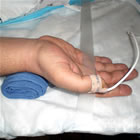 This is very big news.
This is very big news.
Today the European Association of Percutaneous Cardiovascular Interventions (EAPCI), the Acute Cardiovascular Care Association (ACCA) and the Working Group (WG) on Thrombosis of the European Society of Cardiology (ESC) published their joint consensus document on the radial approach to PCI, online ahead of print in EuroIntervention.
In a press release, the European Society of Cardiology stated:
“The radial approach for percutaneous coronary interventions (PCI) was developed 20 years ago and is used for more than 50% of procedures in France, Scandinavian countries, the UK, Spain and Italy. Despite the advantages of radial access some countries in Europe such as Germany use radial access for fewer than 10% of PCI….
“Evidence has accumulated in the literature showing the benefits of radial over femoral access for PCI including reduced bleeding and improved survival. In addition, the development of smaller and thinner devices has made the radial approach increasingly practical.”
Even though Dr. Oz recently referred to wrist angioplasty as “a radical new procedure”, this two-decade-old technique is used far less in the United States than in any European country! Or China, India, and Japan.
The ESC position paper surveys all the major transradial vs femoral studies and contains extensive recommendations for patient selection, physician training, technical requirements, and hospital organization. The concept of “radial first,” in which the radial approach is the default approach, is shown to be feasible, cost-effective and preferable in numerous circumstances, including STEMI.
Of course, as I also have written, the advantages to the patient are numerous. The consensus documents ends with a section addressing patient preference:
“From a patient perspective, radial access offers significantly less discomfort and significantly improved quality of life as compared to femoral access. Patients who have experienced both access routes strongly prefer radial access, primarily explained by their ability to mobilise immediately after the procedure. Patients in the RIVAL trial when asked what approach they would like for a subsequent procedure much more commonly preferred radial. Cooper et al noted reduced back pain (p<0.0001), reduced difficulty walking (p<0.0005) and improved social functioning and mental health (p<0.01) with radial access. More recent publications have shown that radial access is associated with reduced procedural discomfort and that TRI is more acceptable than femoral access amongst elderly patients.”
Angioplasty.Org will be posting an extensive review and synopsis of this consensus document in the next couple of days.
But this is a big deal because the radial approach has just started taking off in the U.S. There are many reasons why the U.S. is so behind other countries in this technique. But as more and more physicians become trained and proficient in this technique — and more and more patients start demanding it(!!) — the percentage of radial PCI in the U.S. will increase exponentially from the recently reported 6.9% (see “Annual Report” of Stent Procedures Shows Big Increase in Wrist Angioplasty). Yes, 6.9% is a low figure, but it represents a five-fold increase from just a few years earlier!
For six years now, Angioplasty.Org has publicized and promoted the transradial approach through its Transradial Center, featuring information, news, interviews with leading experts, a list of training courses for cardiologists and nursing staff and a radial hospital locator, so that patients can find hospitals and doctors who practice the wrist approach.
I look forward to seeing this technique made much more widely available in the United States and believe that the ESC consensus document will have a significant role in the transition from femoral to radial access.




Just wondering if you could help with a point of clarification. Have just read with great interest the EuroIntervention report. The authors note that “most prefer to start with slightly more expensive commercially available radial access kits.” Is Terumo the only supplier of such targetted kits at present? Is there clinical data to support the superiority of the Terumo kit components. I saw Dr Kiemeneij et al (Cath Cardiovasc Interv 2003 Jun;59(“):161-4 on the Terumo Radiofocus sheath.
Many thanks and best wishes,
Felicity
Dear Dr. Felicity House (Interesting name. You wouldn’t be one of these doctors, would you?) — There are a variety of transradial-specific catheters, wires, sheaths, etc. on the market from a number of manufacturers: Medtronic, St. Jude, etc. Two complete transradial kits we’re aware of, besides the Terumo Radifocus, are the Radialsource from Cordis and an interesting one from Teleflex (formerly Arrow). I don’t believe there is clinical data to support one or the other — it usually comes down to operator preference.
Great Post !! An activated patient is endeavoring to do whatever she or he has to do, to get what they know in their gut they need, in order to feel well and in control, hopeful and moving forward.